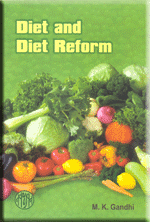
P.O. SEVAGRAM, DIST.WARDHA 442102, MS, INDIA. Phone: 91-7152-284753
FOUNDED BY MAHATMA GANDHI IN 1936
DIET AND DIET REFORM

DIET AND DIET REFORM
Table of Contents
PART-I
- SECTION I: General
- My Faith In Vegetarianism
- The Moral Basis of Vegetarianism
- Diet For Brahmacharya
- Green and Dietetic Ahimsa
- 'Food Faddists'
- Unfired Food Experiment
- Unfired Food
- Unfired Food
- Unfired Food
- National Food
- Minimum Diet
- For Four Rupees A Month
- A Talk to Village Workers
- Minimum Diet
- Plea for More Fruits
- Carrion-eating
- SECTION II : Rice, Wheat and Gur
- SECTION III : Soya Beans and Ground-nuts
- SECTION IV : Green Leaves, etc.
- SECTION V : Milk
- SECTION VI : Ghee and Oil
PART-II
- SECTION I : General
- Precautions Against Ills of The Season (M.D.)
- Dietetic Changes (M.D.)
- Mortification of The Flesh (M.D.)
- Vitamins - I (P. C. Ghosh)
- Vitamins - II (P. C. Ghosh)
- Physiological Basis of Nutrition
- Are you acid? (H. C. Menkel)
- What And How Much To Eat? (H. C. Menkel)
- Question on Diet (H. C. Menkel)
- Improved Diets (A. K.)
- Place of Cereals in Food (I. Amin)
- An Experiment in National Diet (Pyarelal)
- Revealing Figures (A. K.)
- SECTION II : Rice, Wheat and Gur
- The Miracle of Unpolished Rice (M.D.)
- Unpolished v. Polished Rice (Prof. Basu)
- Saving Cereals (D. K. Gupta)
- Useful Suggestion (M. A. Chadray)
- White v. Brown Sugar (M. D.)
- The Havoc of Sugar (M. D.)
- Bad Teeth and Refined Carbohydrates
- Potentialities of Palm Jaggery (Gajanan Naik)
- Nira - A Nutritious Beverage (Gajanan Naik)
- SECTION III : Soya Beans and Ground-nuts
- Warning against Soya Beans (M. D.)
- Soya Beans (M.D.)
- Soya Bean Recipes
- A Soya Bean Book (M. D.)
- The Utility of The Ground-nut (A. K.)
- SECTION IV : Fruit
- The Merit of Amla (A. K.)
- SECTION V : Milks
- Kimmed Milk and Buttermilk (W. R. Aykroyd and S. C. Dasgupta)
- SECTION VI : Ghee And Oil
- Edible Oils (P. C. Ghosh)
- Blindness At A Price (J. C. Kumarappa)
- Nakali Ghee (J. C. Kumarappa)
- SECTION VII : Tea
- Another Rising Menance (J. C. Kumarappa)
- Non-English Words With Their Meanings
About This Book
Written by : M. K. Gandhi
Edited by : Bharatan Kumarappa
First Edition : 5,000 copies, July 1949
ISBN : 81-7229-062-4
Printed and Published by : Jitendra T. Desai
Navajivan Mudranalaya,
Ahemadabad-380014
India
© Navajivan Trust, 1949
Download
Chapter 27: Green Leaves
Take up any modern text-book on food or vitamins, and you would find in it a strong recommendation to take a few edible green leaves uncooked at every meal. Of course, these should always be well washed half a dozen times to remove all dirt. These leaves are to be had in every village for the trouble of picking. And yet greens are supposed to be only a delicacy of cities. Villagers in many parts of India live on dal and rice or rod, and plenty of chilies, which harm the system.
Since the economic reorganization of villages has been commenced with food reform, it is necessary to find out the simplest and cheapest foods that would enable villagers to regain lost health. The addition of green leaves to their meals will enable villagers to avoid many diseases from which they are now suffering. The villagers' food is deficient in vitamins; many of them can be supplied by fresh green leaves. An eminent English doctor told me in Delhi that a proper use of green leaves was calculated to revolutionize the customary notions of food and that much of what was today being supplied by milk might be supplied by green leaves. That, of course, means elaborate research and examination in detail of the nourishing properties of the innumerable leaves that are to be found hidden among the grasses that grow wild in India.
For nearly five months I have been living entirely on uncooked foods. I used to take what appeared to me an enormous quantity of a vegetable every day. For the past five months I have been taking green leaves in the place of cooked leaves or other vegetables. It then seemed to me monstrous that I should have to depend upon the Wardha bazar for the few ounces of leaves I needed. One fine morning Sjt. Chhotelalji of the Wardha Ashram brought to me a leaf that was growing wild among the Ashram grasses. It was luni. I tried it, and it agreed with me. Another day he brought chakwat. That also agreed.
Since these were received, I had introduced to me the leaves ofsarsav, suva, turnip-tops, carrot-tops, radish-tops and pea plant leaves. Besides these, it is hardly necessary to state that the radish, turnip and carrot tubers are also known to be edible in their raw state. It is waste of money and 'good' taste to cook these leaves or tubers. The vitamins contained in these vegetables are wholly or partially lost in cooking. I have called cooking these waste of 'good' taste, because the uncooked vegetables have a natural good taste of their own which is destroyed by cooking.
Harijan,
15-2-1935